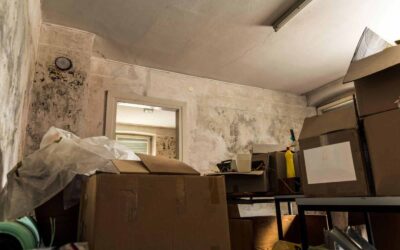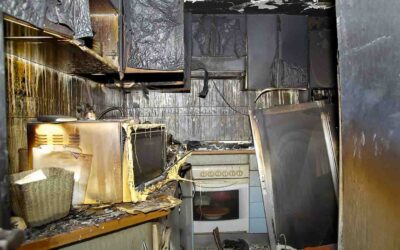Black mold. While it might sound like a freaky fungus monster from the likes of Dungeons & Dragons, it is very much real. However, just because it isn’t a creeping nefarious monster lurking in the darkness, that doesn’t make it any less frightening for homeowners. In this article, we’ll explore why the term “black mold” is actually a bit of a misnomer, how it’s toxic mold that affects people and homes, and what the telltale black mold signs in a house might be. Plus, we’ll discuss why early detection and intervention are so important.
What Is Black Mold?
“Black mold” is a common term that people often use to refer to any type of dark, greenish-black mold. It’s typically associated with poor indoor air quality and health issues. However, “black mold” gets a bit of a bum rap. There are many molds that are black that really aren’t actually that harmful, and there are many molds of different colors that are just as or even more harmful than black molds. Basically, color has no bearing on whether a mold is toxic or not.
Toxic mold is what homeowners need to watch for signs of, and it comes in many different colors. It thrives in high-humidity environments and typically grows on materials rich in cellulose, like wood, paper, and cardboard. It often appears in places with significant water damage. If you spot signs of toxic mold in your house, you should act quickly to mitigate the problem.
Where Is Toxic Mold Found?
Toxic mold prefers environments with high humidity and ample organic material to feed on. Some of the most common areas to find toxic mold in a house include:
- Bathrooms under sinks, around bathtubs, and in showers.
- Kitchens under sinks and around leaky pipes.
- Laundry rooms around washing machines and dryers.
- Basements and attics in places with water damage or condensation.
- Walls and ceilings, particularly in places with poor ventilation or past water leaks.
Toxic Mold Signs in Your House
What are the indicators of toxic mold presence in a house? Here are some of the most common signs of toxic mold to watch out for:
Visible Discoloration
The most obvious toxic mold signs in a house are visible growths. These growths are most commonly green, brown, white, or black, but they can be just about any color. While not all mold is toxic mold, many different types can still have negative effects on the body, so if you notice any sort of growth, it should be investigated. You may need to call in the experts.
Musty Odors
A persistent musty smell is often a telltale sign of mold. This odor is produced by microbial volatile organic compounds (MVOCs) released during the mold’s growth cycle. If you notice an earthy, damp smell in your home, it’s probably worth investigating further.
Health Symptoms
Exposure to toxic mold can cause various health issues, especially for those with allergies, asthma, or weakened immune systems. Common symptoms to look out for include:
- Respiratory issues—coughing, wheezing, shortness of breath, and nasal congestion
- Eye and skin irritation—red, itchy eyes and skin rashes
- Throat irritation—sore throat and hoarseness
- Neurological symptoms—headaches, memory loss, and cognitive difficulties
- General symptoms—fatigue, dizziness, and digestive problems
It’s worth noting, of course, that many of these symptoms mimic other afflictions, such as the common cold or seasonal allergies. So, if you have a persistent sore throat, for instance, don’t panic. Unless you see other signs of black or any other color mold in your house, the symptoms may be unrelated to mold growth.
How (and Why) To Deal With Toxic Mold Before It’s a Larger Problem
As the proverb goes, an ounce of prevention is worth a pound of cure—and dealing with toxic mold is no different. It’s always worth checking your home for some or all of the above signs to ensure you identify the early signs of toxic mold before it fully takes root.
Early Detection and Prevention of Toxic Mold
Detecting toxic mold in your house early can prevent extensive damage to your home and health risks to any residents. Here are some fairly low-effort ways to spot toxic mold before it becomes a real problem:
- Do regular visual inspections on areas prone to dampness and leaks for any signs of mold.
- Use hygrometers to keep an eye on humidity levels in your home, and keep indoor humidity below 50 percent to deter the growth of humidity-sensitive toxic mold.
- If you suspect mold but can’t see it, consider hiring a professional. Indoor Environmental Professionals (IEPs) can use specialized equipment to detect hidden mold.
Why Is Early Intervention for Toxic Mold So Important?
Toxic mold, if it spreads, can be a time-consuming, expensive fix. And it isn’t just your wallet that will be hurting. There are numerous reasons to want to fight toxic mold:
- Mold can cause significant damage to your home’s structure. Wood, drywall, and other organic materials can deteriorate rapidly when infested. Early detection and intervention can save you from costly repairs and renovations down the line.
- Mold exposure can lead to severe health problems for you, your family, and even your pets. This is especially true for vulnerable individuals. By addressing mold issues promptly, you can protect your family from potential respiratory illnesses and other health concerns.
If You See Signs of Mold in Your House …
- Identify and fix moisture sources. Mold can’t grow without moisture. Fix leaks, improve ventilation, and use dehumidifiers.
- Remove affected materials. Severely infested materials like drywall and carpeting may need to be replaced entirely.
- Use appropriate cleaning agents to clean affected areas. Non-toxic cleaning products are recommended.
- For extensive mold problems, don’t go it alone. Hire professional help to ensure that your home is safe.
If you want expert mold services in Oregon and southwestern Washington State, the experts at Biodynamic can help. We take the time to ensure that we get the job done right the first time. For trusted, professional mold removal, call Biodynamic.


